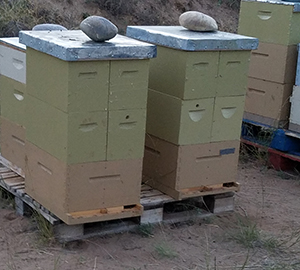
One of the most basic parts of beekeeping is figuring out how not to lose all your bees in one year. Beekeeping is hard. A couple of fun quotes from mentees sum it up well … “I’ve figured out the worst thing I can put in my hives … my hands”; and, “I haven’t discovered yet how I’m going to kill my bees this year.” I have to disagree with the first guy, although I understand the sentiment. Even when I don’t know what I’m doing to help my colonies survive, the ones I pay the most attention to are the ones least likely to die. My colonies in out-yards are the most likely to die. The best thing you can acquire to ensure your bees’ survival is experience. Get out there, get in your bees, and learn (not more than once a week, or they’ll learn to hate you). This is one of the reasons we have been encouraging you to learn to do powdered sugar rolls, and to get your courage up and split your colonies when they need it. Everything you accomplish not only helps your bees, but it helps you learn and gain experience.
This month, I am encouraging you to pull a late summer nuc for yourself. It might sound scary, but it is fairly basic, helps you gain experience, and most importantly, gives you what is called a resource hive. A resource hive is insurance against doom. The late summer nuc, The Resource Hive, gives you an extra queen in case you lose one, it gives you eggs to donate to a colony so that they can raise their own queen, extra bees in case a skunk eats a bunch of your big colony, or sheets of brood to normalize pheromones while waiting for a queen to mate. It is pretty important. You may have more than one big colony, but you aren’t going to want to take the queen out of one big colony to give to another, and you may not want to steal resources from a production colony that may handicap its production.
Convinced? Here’s what you need. First, you need another hive body, top, bottom, and feeder. This works best if you have at least two colonies to pull from. Even colonies that started out this year as packages should have enough resources by the first of August for this to work. You aren’t expecting to get honey this year anyway, trade that in for bee survival. If your two colonies have filled two deep hive bodies, or three medium hive bodies, you have enough bees, and hopefully enough honey to share with your nuc.
The definition of “nuc” is nucleus of bees, and that is what we are going to create. At a minimum, a late summer nuc needs three frames of brood, a queen, two frames of honey and bee bread, the bees that are on these frames, and room to work. We are going to put our new nuc into a full-size hive body, not a five frame nuc body, unless the nuc box can be supered. You can pull one frame of brood from your weaker hive, and two frames (or bars!) from your stronger hive. If both are strong, you can make your nuc super strong by giving them two frames of brood from each. Take the two frames of capped brood from the stronger hive. They can afford to lose the bees that they put the time and resources into raising. Take a frame with mostly open brood from the weaker hive. It has not cost them much in the way of resources. Capped brood boosts the population very quickly, while a frame of open brood and eggs allows them to raise a queen if they need to. Take one sheet of mixed honey and bee bread from each parent colony to give to the nuc.
It is all right to just put the bees from the different colonies in the new box together. They might ….


